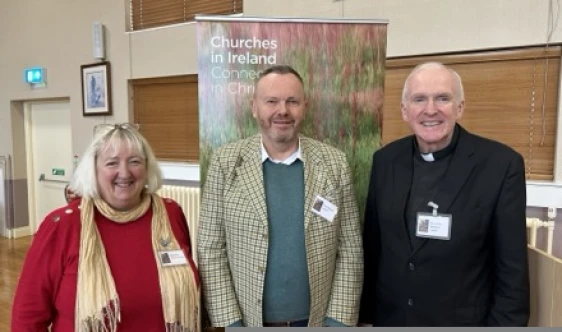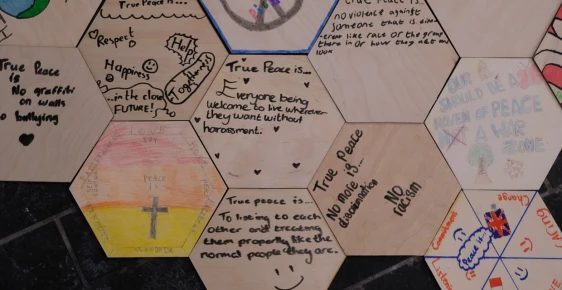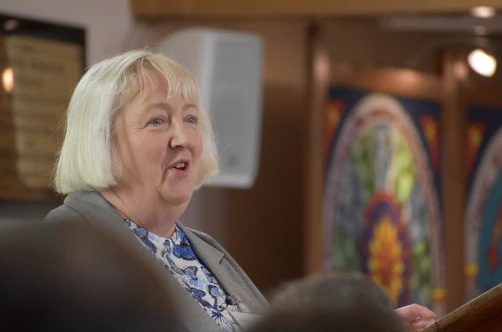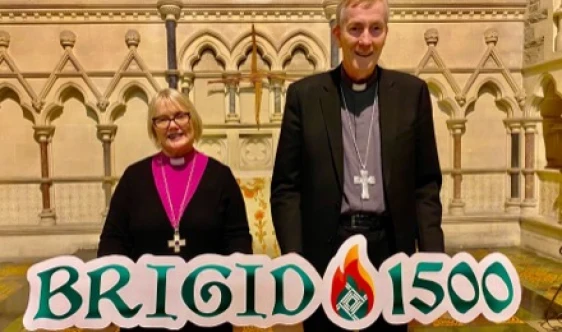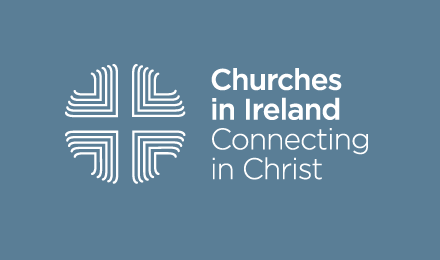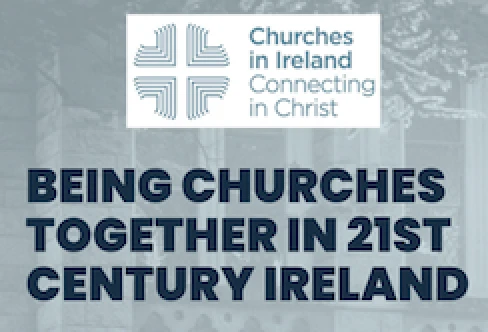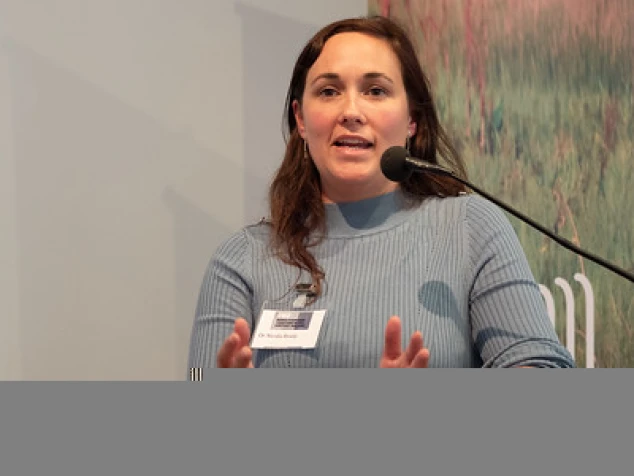
Witnessing together: How churches build connection and work together effectively
Introduction
The question that has been posed for me here — how churches build connection and work together effectively — encompasses much of what has been coming up in conversations in inter–church structures across the world, national and international, where people have been reflecting on the relevance of the work the churches are doing together, how effectively we are working together through existing structures and how we deal with those issues that can put pressure on relationships.
I am conscious of how much experience we have in this room, so what I hope to offer are some questions and reflections that can help focus our discussions throughout the day, thinking particularly about how we build on what has been achieved already through ICC and IICM and explore possibilities for the future and further development of that work.
The first question I want to put to you is: what do we mean by building connection. For this presentation I have understood it in terms of the following relationships:
- Between the member churches of IICM (the foundational relationships for the work that is done together).
- Between the national inter–church structures and the local church context (an area that has been a particular focus of attention for IICM in recent years).
- With wider civic society including other faiths.
- With Government and other policy makers.
(With both these last two being critical in terms of the work the churches do together for the common good.)
If there’s anything anyone feels is missing it would be good to pick that up in the discussion.
I know we’re all very aware of the challenges of the current context, so I’m hoping we can focus more on the opportunities, starting with the fact that the time that you’ve all invested in being here today is in itself a very positive statement about the churches commitment to working together.
And so my next question is: what do we want to say about that? What is the story that we want to tell about what we are doing here and why we are doing it?
To help us answer that question, I want to encourage us to reflect on three areas: context, purpose and process.
Context
By context I mean both the context you are speaking into, and the context you are speaking out of.
I’m sure we can all agree that the context ICC/IICM are speaking into is a particularly unsettled one, with a high degree of uncertainty and insecurity.
The cost–of–living and housing crises are leaving people very fearful as we head into another winter. Debates around issues of identity and belonging are becoming increasingly polarised and sometimes dehumanising. Globally we’re dealing with multilayered, interconnected crises and closer to home we’re seeing crises in major public institutions, like policing and public service broadcasters. In this kind of climate, both national and international, many bad actors are not getting the scrutiny that’s needed, whether that’s big multinational corporations, organised crime, racist and far right movements and the list goes on.
So I know what you’re thinking — does she have any good news? And the answer is yes, I do want to make the point that the very troubling picture I’ve just painted is not the full story. We can all of course share many inspiring examples of leadership, and community resilience, and people choosing the path of justice and solidarity even when it comes at great personal cost.
And not only do these stories exist, but in my experience, and contrary to the impression you might get from reading the papers or listening to the radio, people do want to hear them. They want to hear hopeful messages, to see leadership that contributes to healing. I think the story that you have to tell about the work that has developed through ICC and IICM is a very good example of that.
So I was very encouraged to see that the launch of Dr Ellis’ book was part of the programme for today. A significant anniversary offers a space to reflect on the journey IICM has been on, but it’s also a critical opportunity to get everyone on the same page in terms of the understanding of where the structures have come from and the decisions and choices that have shaped the structures and processes you have today. It’s a useful exercise to do periodically because it helps build members’ confidence in talking about IICM, and to convey a coherent identity. If someone asks three different people what IICM does or what it is for and gets five different answers it doesn’t have quite the same impact. So I think that would be one recommendation from me, that there’s an opportunity here to develop some clear talking points about the development of IICM and the journey the churches have been on together through these structures and to do this with close attention to the context you are speaking into.
What is relevant from that learning for the challenges the wider society is facing today — what hope can you offer from that experience?
Purpose
There are a number of things that stand out for me when I look back on the history of ICC/IICM and how they have developed. The first is that you can really see how relationships of trust and mutual understanding have deepened over the years, allowing it to move from a place where there were more formal exchanges about things the individual denominations had already discussed and decided, to a place where church representatives brought their questions, challenges, the things they were working through.
With this comes the challenge that there are a lot more issues the churches are not only willing to work on together, but are very keen to work on together. So there have been structural changes to reflect that and difficult choices to address what I would see as a tension between stability and flexibility — where you moved from having support structures (like fora and working groups) that were established on a long–term basis with detailed Terms of Reference and reporting into the central structures on a regular basis to one where a wide range of working groups could be convened on a short–term basis to look at particular questions or issues and report back to the next meeting of the central body.
I’ll say more about this when I come to talk about process, but personally I think this more flexible approach has allowed IICM to be more responsive to emerging issues, and to make best use of the time offered by church staff and volunteers by giving them clearly defined areas where they can make a contribution, with quite a sharp and specific focus. But I would underline that the success of this kind of model does depend on having a central structure that works well, that takes decisions in a timely manner, communicates clearly about those decision–making processes and fosters the kind of relationships that facilitate collaborative working.
For this reason I think it’s important to have the conversation about purpose periodically, because in setting out clearly what you are trying to achieve you establish the markers against which the impact and effectiveness of the work can be measured.
The very fact of the churches coming together in IICM is important — as churches in Ireland connecting in Christ. That showing up and standing together has value. Meeting together, working together, undoubtedly has benefits for the churches and the individuals who participate, but it also needs to be about something bigger. How we rate the effectiveness of our structures really depends on how we define their purpose and at a time when churches are under pressure in terms of resources we can expect hard questions to be asked.
Our understanding of the over–arching objective might be something like this:
To share the Good News of the Gospel through word and action so that people have the opportunity to know Christ.
In terms of the practical outworking of that, a structure like IICM can help churches to achieve this in a range of ways, including:
- Visibility and awareness (symbolic and visual representation of the churches’ working together);
- Space for fellowship and relationship–building;
- Vehicle for collective action — practical, organisational, financial support to action and engagement;
Now you may well feel that if you have an inter–church structure that is functioning well it will be delivering across all of those areas, and that is true to an extent, but we can’t always do everything and there can be tensions between the different areas. So, for example, if you have a lot of activity happening, you will have very full agendas for meetings with important decisions to be taken on texts, partnership agreements, expenditure etc. and it doesn’t leave a lot of time for open dialogue and relationship–building work. Conversely, you could have really rich dialogue that leaves participants coming away with a sense of deep fellowship, but perhaps insufficient externally–facing work to help connect the wider church and the local church to that fellowship.
An important question for me is that of ownership. National inter–church structures should be at the service of their members, but at the same time they shouldn’t be simply service providers. The difference as I see it is between the members saying on the one hand ‘that’s what IICM does’ and on the other ‘that’s what we do through IICM’.
Process
Over the years the IICM has developed processes that in my view have helped to create more connections and widen participation in the work. I just want to take a few minutes to talk you through what I think works well about this process.
I would describe it in broad terms as going through the following series of steps or phases:
1. Reflection
This takes place in the core group, in this case the inter–church meeting itself or the Irish Inter–Church Committee. One of the strengths of a forum for regular structured dialogue like IICM is that it gives you the space to be proactive, rather than purely reactive in your engagement. There will of course always be times when you have to respond to urgent and external developments but often in IICM there is both time and space to design processes for engagement that help to maximise connection.
In the course of this reflection the core group identifies the priority issue or issue to be worked on and does some initial work in terms of defining the problem or key questions, offering some initial language and parameters as a starting point.
2. Listening phase
- In an IICM context this has typically taken the form of workshops — involving representatives of member churches, faith–based organisations and sometimes others to bring a range of perspectives and relevant expertise.
- Some of what is done in those workshops could be described as mapping, and sometimes people roll their eyes when I say that because it sounds too corporate or technical for churches, but it’s actually really important in relational terms. If you overlook existing work you can turn potential allies into critics and it can really damage your credibility.
- Then there’s what might technically be called stakeholder analysis where you look at questions around who needs to be involved and engaged, understanding your potential audiences and prioritising accordingly.
- A really important question at this point is: who are we not hearing from? In response to this we’ve seen targeted outreach for youth perspectives, to get the views of people who are new to Ireland with a different experience of the history
- Testing the language — being aware of any sensitivities. The framing of the issues is really important. We understand that we’re not going to please everybody. The one thing you can be guaranteed in making a contribution to the public square is a challenge, but being courageous is not the same as being careless and when dealing with issues of identity and belonging we have to show due care around issues like trauma and alienation.
- From these workshops we look for suggestions for actions that are meaningful to the practitioners on the ground.
3. Discernment
- The core group receives the report and analysis and discusses.
- As part of this phase we’re looking for clear consensus around the values we want to articulate — where we are coming from in our approach to this issue.
- What resources do we have? I think this has been one of the positive developments in recent years. Previously I think there was perhaps more of a disconnect between the people who were coming up with the ideas and proposals and the people who were doing the work and managing the resources, and that disconnect was disheartening for all involved. Widening the consultation and input into the design of work plans help to achieve better alignment with the skills and experience and existing priorities of the people you have. It also forces us as part of the design process to address the difficult questions like: “if we invest energy and resource in this issue, where might that be drawing attention away from?”
- At the same time, a body like IICM, with that space to be reflective and proactive can have an important role to play in challenging the churches and drawing attention to those areas that are not top of the pile on people’s desks, but perhaps all the more worthy of attention because they risk being neglected.
- A vital question to ask at this stage is: what does success look like? I still find this question being overlooked quite often in a church context. It may be because there is a desire to do something as soon as possible, or because people are following familiar patterns in terms of action (we’re concerned so we issue a statement), or sometimes there’s a resistance to the accountability challenge this question poses. But for me this is a really important step because the actions taken should reflect the goals. So if your priority is to inject some language into the public discourse on a particular issue then you will want to focus on areas like media engagement — statements and interviews — and meetings with leading figures in that particular debate. But if your priority is to mobilise the local church on an issue then a statement will be of limited value and you should be looking instead at initiatives like training and local engagement events. I would argue that where resources are limited we can’t afford to jump into action without a framework for evaluation to assess impact and effectiveness.
(We then move to the action phase, but it’s important to note that the listening and discernment stages are sometimes repeated several times to get a refined plan — something that the IICC is happy with and also has sufficient support and buy–in from the key people doing the work on the ground.)
4. Action
- An important learning for me in recent years has been the need to ensure that we have substantial theological reflection as a foundation for any action. We can be so focussed on the doing that we can take for granted that we all have the same understanding of why we are engaging in this area or in this way, but that is not always the case. A useful exercise that was done in IICM around issues of migration and asylum and later on climate justice was to develop and adopt a series of affirmations. This had the benefit of giving a solid foundation for the work, but also providing a really useful communications and educational resource.
- The approach to the issue of housing insecurity and homelessness through bible study is another good example of churches using the unique resource that they have to engage a particular and very significant audience and offer a different way in to a challenging debate.
- Of course as we know much of the action undertaken by IICM is dialogue–based and here I just want to take a moment to acknowledge some of the significant features of that contribution: in recent years we have seen IICM recognise and use its convening power to bring a wide range of people together for issues that impact the common good, being courageous in including in those invitations people who will be critical friends with challenging things to say to the churches, modelling the kind of unity in diversity we would like to see in the wider society by being honest about the fact that we have different views and experiences on some issues of identity and belonging but that the relationships that hold us together are much deeper and more important than that.
- There has been focussed outreach to local groups and the wider faith sector through documents that were circulated for consultation and feedback, like the paper on pastoral dimensions of Brexit, or the Unfinished Work of Peace strategy. And there have been various forms of research undertaken through surveys and focus groups to really understand the challenges facing the local church and identify shared priorities.
- Political engagement — this could be a whole topic in itself so I am going to limit myself to a few observations about good practice in this area:
- The framing of this type of engagement is critical: invitations, from whatever source, should convey mutual respect, and recognition of the different roles and responsibilities of faith and political representatives Pastoral perspective — churches make a unique contribution to the debate by bringing out themes like friendship, and recognising that politicians are human beings, with families, who will be personally impacted by the issues being discussed. Having both clear messages about shared priorities and being comfortable with diversity of opinions and experience, modelling that friendship that recognises and values difference. Amplifying the voice of local communities, those doing front line work — bringing case studies and real life examples which provide insights that those drafting policy might not have access to. Engaging beyond the faith sector to encourage and promote wider civic leadership and good practice in civic–political dialogue.
5. Communications
When you look back on it there is a huge body of work with great variety in terms of both issues and approaches, and I would argue a lot of good practice in terms of listening and engagement.
And so we turn to the area of communications and the question of whether this work is sufficiently well known or understood.
I think many of us would feel that there is an opportunity for further development in this area and I would suggest a few areas for attention.
- The first is to reiterate the point about having clear talking points on the story that we want to tell about IICM. I know this work is already underway as part of the anniversary year, with media engagement around the anniversaries and articles in church magazines. The positive response to these should be an encouragement to continue that work of developing the recognition and understanding. The story of the development of IICM is one that points to the development of a sense of collective responsibility across the churches, but there is perhaps more that can be done in building a shared identity in IICM.
- Related to that is the point about priority focus on theological reflection. Personally I feel that IICM should be an important space for member churches to develop a collective Christian perspective to bring to the wider public square. This doesn’t take away from inter–faith and wider civic and political dialogue, but rather strengths it through being clear about what the Christian voice adds as one perspective among many.
6. Evaluation
The inclusion of this phase seems self–evident in terms of good practice but this is the part that often gets missed because of pressures and the push to move on to the next thing.
Making time for evaluation offers an opportunity to document what was done and strengthen institutional learning.
It is an opportunity to learn from what worked well and be intentional about repeating, as well as sharing that good practice.
As part of this process it is important to ask the people who did the work how that experience was for them as a way valuing people’s contribution and demonstrating that ethos of care for the person that reflects our values.
We can get useful learning from things that didn’t work as intended. It may be daunting to face into a conversation with people where you know they are disappointed but in my experience the willingness to learn from their experience and to document it can really transform those kinds of situations.
Other important questions to ask include: Did the methodology align with the goals? What was the lasting impact.
Conclusion
In drawing this to a close then, It’s not going to come as a surprise to anyone that I recommend inter–church cooperation as the starting point for effective action. The pace of change, the scale of the challenges, is such that we need to work together just to keep up. As with all major institutions the credibility of the churches is under scrutiny, and our contributions need to be well–researched and I find in my work that pooling our resources is essential to achieve that.
My objective for this presentation was not to tell you how to do the work of witnessing together and building connections but rather to draw attention to the value of the experience that has been built up in ICC/IICM over the years and help you to think through how you make the most of that, conscious that there will always be difficult choices before you because the resources will always be less than the level of need, but I hope this reflection will be helpful to you in discerning which actions will have the greatest impact and contribution.
